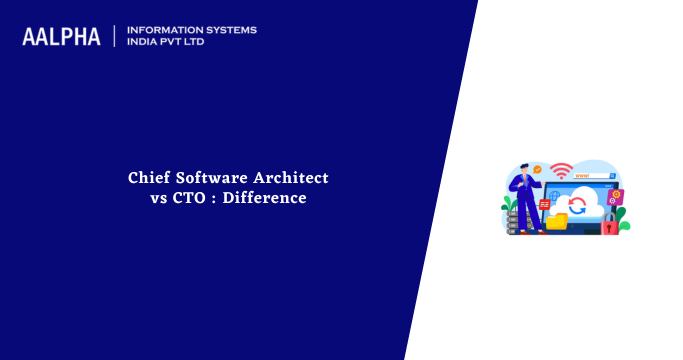Most companies are struggling in staying ahead of the curve. The current tech landscape is so dynamic and rapidly evolving. Organizations need to understand the roles of Chief Software Architect (CSA) and Chief Technology Officer (CTO), which are key in steering their technological direction. The two positions may appear similar, but they have unique differences, especially when you base them on their distinct responsibilities, skill sets, and the impact they create on a given company. When it comes to software development, a developer’s success as an engineer depends on their education, expertise, skill set, and experience. The attributes also count greatly in the project’s success and how they steer the company to compete.
Organizations should take the step of understanding the two to effectively leverage their technical capability. Once they have a clear understanding of the differences, companies can capitalize on that in making informed decisions on leadership structure and improving the career path of their professionals.
There is a high demand for technology leaders. Between 2019 and 2029, there is an anticipated faster employment growth rate of about 11% when it comes to computer and information technology-related careers compared to an average of other careers combined. Such an increase is attributed to many companies relying on big data, information security, and cloud computing. Within this space, CTO and CSA roles stand out distinctly.
The General Overview
A Chief Software Architect’s primary focus is the design and development of various software systems. Such individuals are responsible for creating high-level software architecture, making choices on the technology stack to use, and implementing software checks to ensure the attainment of current and future needs. Many attribute the success of a project to a well-defined software architecture.
The Chief Technology Officer is in control of the general technological direction of a given company. Their tasks include developing a vision, ensuring technology initiatives align with the business goals, and managing the company’s IT team. The recent digital transformation moves have made CTO roles to be more critical. CTOs are known to drive innovation in a firm and ensure the available infrastructure supports a company’s growth rate and improves the competitive edge.
This article addresses the roles and responsibilities of a CSA and a CTO. We gauge them regarding skills and qualifications, their impacts on companies and see a defined career projection.
Defining the Roles and Responsibilities
The core responsibility of the Chief Software Architect (CSA) is handling the design and architecture of software systems in a given company. They have the mandate to ensure the software meets the company’s business objectives, scalability is achieved and can easily be maintained. On the other hand, the Chief Technology Officer (CTO) is in charge of the technology landscape for the organization. The landscape can go beyond the tech strategies, the ICT infrastructure, and innovation concerns. CSA is much into the architecture and technical elements, while the CTO has a wider scope to include strategic planning and alignment of tech to a company’s business objectives.
Comparison of Responsibilities:
-
CSA Roles and Responsibilities:
The CSA is in full charge of the software development cycle, engaging stakeholders and directly reporting to the CTO.
- Fully responsible for the hands-on coding for a given software project
- They design the software architecture and guide the maintenance process of legacy software
- Responsible for the entire DevOps process and the backend code
- Manages the team on a daily basis
- Must provide solutions to tech stack issues
- Ensures attainment of quality code and standards
- Overseas the smooth collaboration with development teams plus CTO and provides them with status reports of the different tasks
- Ensures the efficient execution of the budget
- Must facilitate the best choice when it comes to needed tools and languages to implement the code
-
CTO Roles and Responsibilities:
We have seen that the CSA controls the bottom-level software development. The role of the CTO directly relates to the long-term business strategy in a given company. Some of the main roles and responsibilities include:
- Developing the technology or technical strategy for the project and product’s future in conjunction with the CEO
- Supervising IT infrastructure
- Monitoring the cutting-edge technologies within the ever-changing market to drive innovation and technological growth
- Assessment of a product and its potential within the competition landscape
- Responsible for research and value addition to a product
- Plays a part in the hiring process of key personnel for project implementation
- Acts as a team leader to resolve technical and internal matters
- Sets the goals, both short-term and long-term
- Analyzes possible risks and advises appropriately on the measures to take
- Work along side the marketing team to create a promotion strategy for the product
- Supports the CSA in other matters
Skills and Qualifications
CSA Key Skills and Qualifications
The software architect is known to develop high-level design picks and set the technical standards. Such include the tools of use, the coding standards of the software, and platforms or frameworks to utilize. To succeed as a CSA, one must possess extensive technical knowledge in framing appropriate decisions. It goes beyond technical knowledge and requires soft skills, which are pertinent when managing people and projects. Here are some of the important skills and qualifications:
Hard Skills
- Extensive Technical Knowledge: There is a need for the CSA to be well-versed in software development, including the popular programming languages and frameworks applicable to a given firm. The need to understand such languages as Java, Python, JavaScript, or C#. They should understand software patterns and development methodologies like Scrum, Agile, and DevOps.
- Coding Skills: A CSA should have a deep understanding of the software development process to help them effectively lead a team of developers. They should communicate tasks clearly to avoid confusion, ensure consistency by writing reusable code units, and maintain high software standards through strict code quality assessment.
- Knowledge of Cloud Technologies: You can easily find ready-to-use solutions when you explore cloud services, especially when saving time and resources. A CSA should select best-fit cloud tools and decide when to implement them. Such individuals should be familiar with the various cloud computing platforms like Google Cloud, Azure, and AWS.
- Domain Knowledge: One key thing for a CSA to understand is the business domain. With such knowledge, they will devise good approaches to solving problems, enabling effective communication with top executives and aligning with the company goals.
- Architectural Design: CSAs should understand high-level architectural frameworks, microservices and system integration to better grasp developing software architectures. They should attain high levels of scalability, robustness, and maintainability.
Soft Skills
- Team Leadership: A CSA should be an astute leader. Should possess the capabilities of guiding and mentoring a team of developers. Such will involve creating an enabling collaborative environment, adherence to quality, setting coding standards, and giving the appropriate technical direction. For project success, they should earn respect and authority over the team and encourage members to learn and improve continuously.
- Communication Skills: A CSA should embrace effective communication to help in smooth collaboration with stakeholders, product managers, developers, executives, engineers, and business analysts. Communication should include explaining complex concepts, patterns, or technologies in simple terms that everyone will easily understand.
- Problem-Solving Abilities: A CSA is involved with managing system design. They should identify potential technical challenges and find innovative solutions. There is a need to address potential risks in a proactive way to make the system seamless in functionality and meet current and future needs.
- Organizational Skills: A successful software product should achieve a lot with minimal resources. A CSA prioritizes tasks effectively and organizes their team to ensure maximum efficiency, and attainment of deadlines and project milestones.
- Time-Management Skills: A CSA always has a busy schedule, including setting meetings with clients, working with other team members, and holding talks with top management of the company. The success of this means that a CSA should be well-organized and effectively manage their time.
- Creative Thinking: To lead a functional team, a CSA must think outside the box, devise alternative approaches, and solve problems on the fly. Such is necessary to ensure the continuity of the project scope.
- Educational Background: It is a good consideration for the CSA to hold a bachelor’s or master’s degree in computer science, software engineering, or any other related field. There is an added advantage if they possess additional certifications in software architecture or particular technologies.
CTO Key Skills and Qualifications
A Chief Technology Officer (CTO) should be an expert in technology. They should mix technical acumen with strategic vision and leadership abilities. CTO skills are important because:
- They drive technological innovation, placing an organization ahead of its competition
- Assist in navigating challenges for smooth technological operations
- Leadership skills help in team management and cohesion. It can result in inspiration, morale boost, and increased productivity
Let us see some of the key skills and qualifications:
Soft Skills
- Leadership and management: The CTO is responsible for managing technology and leading a team. They should inspire team members, set objectives, delegate appropriately, and create a conducive environment supporting innovation.
- Communication: A CTO must possess superior communication skills to ensure they express the complex technicalities of a project in simple and understandable terms. They explain these concepts to stakeholders, customers, and team members. A CTO should also be a good listener.
- Strategic thinking: A CTO must develop a clear product roadmap that stipulates the technology avenue of an organization and aligns with objectives. Strategic thinking enables the coming up of future needs & challenges and the formulation of comprehensive plans to solve such challenges.
- Problem-solving: Complex problems are part of a CTO’s journey. They need to come up with a well-thought-out solution. Possessing problem-solving skills helps a CTO troubleshoot the issue, come up with possible solutions and settle on the next course of action.
- Change management: Technology is bound to transition and change. CTOs should be in a position to manage and adapt to any adjustments in business processes or technology. Apart from possessing technical prowess, they should lead the team in adopting new transitions.
- Educational Background: A CTO should possess a bachelor’s or master’s degree in information technology, computer science, or any other related field. MBA or business qualifications are an added advantage.
Hard Skills
Soft skills are the foundation of the CTO role. Hard skills ensure a CTO has technical expertise for executing strategies successfully. Here is a list of the key hard skills:
- Technical proficiency: A CTO must be well acquainted with system analysis, programming, cloud computing, and database management. Understand the aspects and be in a position to apply them in real-life scenarios.
- Project management: A CTO should be in a position to plan, organize, and oversee the projects to ensure they meet the timelines and within the stipulated budget. Their prowess here helps in the successful deployment of technology solutions.
- Budgeting and financial planning: Most executives and CTOs need to understand fiscal responsibility. A CTO should come up with IT budgets and manage them appropriately, forecast expenses, and make sure all available resources are effectively utilized.
- Cybersecurity: The current digital age has seen vulnerabilities and attacks on an organization’s systems. A CTO should understand cybersecurity principles and techniques to protect valuable/sensitive data and systems against threats.
- Data analysis: A CTO should possess skills to help understand and interpret data to help make strong decisions. Once they have raw data, they should gain appropriate insights and influence some of the strategic decisions within the company.
Hire CTO experts who excel in these critical areas to lead your tech strategy effectively.
Overlapping Skills and Distinct Differences
Overlapping Skills:
- Both need technical knowledge related to IT infrastructure and software development.
- They need skills in leadership and team management.
- Both should embrace effective communication and collaboration skills.
Distinct Differences:
- CSA: Has more focus on the design and maintenance of software architecture. Much involved in technical details and guides the development team.
- CTO: Focuses more on strategic planning, aligning technology with business objectives, managing the technology infrastructure, and good in external relations.
Conclusion
Both the Chief Software Architect (CSA) and Chief Technology Officer (CTO) are critical players in the success of a tech-driven organization. Each of them has distinct responsibilities and skill sets. The CSA focuses much on technical aspects of software development, intending to build architectures that attain high scalability, maintainability, and robustness. They should possess coding skills, technical know-how, and familiarity with cloud technologies. Possessing skills in problem-solving, communication, and leadership is key.
The CTO has a broader role in strategic focus, controlling the whole tech space of a company and ensuring tech initiatives align with the business objectives. They should be strategic thinkers with high technical know-how, business skills, effective communication and team management.
Both career paths have rewarding opportunities. Take your time understanding their responsibilities and skill requirements to make an informed decision and define your career trajectory.
For more information, get in touch with our software development company : Aalpha information systems!






Share This Article:
Written by:
Stuti Dhruv
Stuti Dhruv is a Senior Consultant at Aalpha Information Systems, specializing in pre-sales and advising clients on the latest technology trends. With years of experience in the IT industry, she helps businesses harness the power of technology for growth and success.
Stuti Dhruv is a Senior Consultant at Aalpha Information Systems, specializing in pre-sales and advising clients on the latest technology trends. With years of experience in the IT industry, she helps businesses harness the power of technology for growth and success.